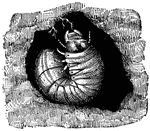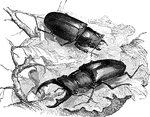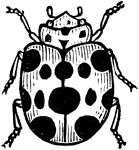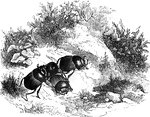
Megaceras Chorinaeus
"The Ateuchi are large, flat insects, with a broudtoothed clypeus. To this genus belongs the…

Larva of Mormolyce Phyllodes
"The innumerable tribe of Harpalidae (or Harpalinae) contains carnivorous beetles of very small size.…

Nebria Arenaria
"They are small almost globular, of a pale yellow with green lines, an live in sand bordering rivers.…
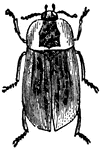
Necrodes Lacrymosa
"They introduce themselves under the skin of the carcasses of animals, and devour their flesh to the…
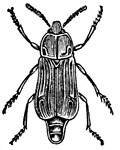
Necrodes Littoralis (Female)
"They introduce themselves under the skin of the carcasses of animals, and devour their flesh to the…

Necrophorus Germanicus
"The Necrophori, or Grave Diggers, are honest undertakers, who carefully bury carcasses left…

Necrophorus Vespillo
"The Necrophori, or Grave Diggers, are honest undertakers, who carefully bury carcasses left…
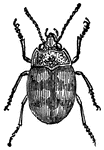
Omophron Libatum
"They are small almost globular, of a pale yellow with green lines, an live in sand bordering rivers."
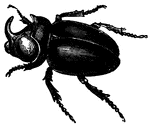
Oryctes Nasicornis (Male)
"A common specimen about an inch long, of a chestnut brown and perfectly smooth. The male, but not the…

Rose Beetle (Cetonia Aurata)
"The rose-beetle frequents roses especially, of which it eats the petals and stamens. They fly by day…

Larva of Rose Beetle (Cetonia Aurata)
"It is found in rotten wood, and often in ants' nests. When it has acquired its full development, it…

Sacred Beetle
"Many of the dung beetles, among which the Sacred Beetle of the Egyptians, Scarabus Aegyptiorum,…

Scarab Beetle
"Is nearly twice as long as the hercules beetle, its color being of a brilliant brown." — Goodrich,…

Scarab Beetle
"The S. nasicornis is a European species, common in gardens, and is noted for a pair of curious…

Scarabaeus (Golofa) Porteri
"Some species collect portions of excrement, which they make up into balls and roll them until they…
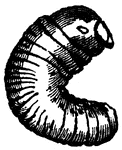
Larva of Scolytus
"Sometimes this larva destroys great forests of oak trees. In 1783, in the Forest of Hartz, 1,500,000…
!["They introduce themselves under the skin of the carcasses of animals, and devour their flesh to the bone. [This] species climbs trees and attacks caterpillars."](https://etc.usf.edu/clipart/53400/53416/53416_silpha_thora_mth.gif)
Silpha Thoracica
"They introduce themselves under the skin of the carcasses of animals, and devour their flesh to the…
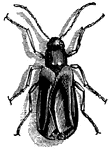
Sitaris Humeralis
"The female Sitaris Humeralis lays at the entrance of the nest of a solitary bee from 2,000…

First Larva of Sitaris Humeralis
"A month afterward there come out of these eggs very small larvae, of a shining dark green, hard-skinned,…

Pseudo Nymph of Sitaris Humeralis
"When the male bees have built the cells and furnished them with honey, the female, as we know, deposits…

Pupa of Sitaris Humeralis
The second larva stage lasts for 6 weeks. It contracts and passes through the winter. "In the spring…

Third Larva of Sitaris Humeralis
The second larva stage lasts for 6 weeks. It contracts and passes through the winter. "In the spring…

Stag Beetle (Lucanus Cervus)
"They live in half rotten trees. Their strength enables them to lift considerable wieghts. They do not…
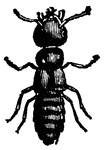
Imago of Staphylinus (Ocypus) Olens
"This specimen lives in the carcasses of animals, on manure, and attacks living insects. It is a carnivorous,…

Larva of Staphylinus (Ocypus) Olens
"This specimen lives in the carcasses of animals, on manure, and attacks living insects. It is a carnivorous,…
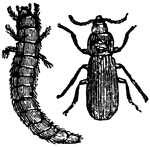
Tenebrio Molitor (Larva and Imago)
"A blackish-brown insect. The larvae are the well-known meal-worms, which live in flour."

Tiger Beetle (Cicindela Heros)
"Their ferocity is remarkable. They quickly tear off the wings and legs of their victim, and suck out…

Under Side of Pupa of Tiger Beetle (Cicindela Heros)
"Their ferocity is remarkable. They quickly tear off the wings and legs of their victim, and suck out…
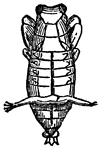
Upper Side of Pupa of Tiger Beetle (Cicindela Heros)
"Their ferocity is remarkable. They quickly tear off the wings and legs of their victim, and suck out…

Tiger Beetle and Larvae
"The common European species, Cincindela campestris, may be found flying and running around…
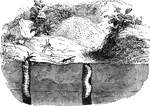
Tiger Beetle Larve
"The common European species, Cincindela campestris, may be found flying and running around…
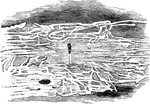
Typograhic Beetle
"The typographic beetle recieves it's name... from the circumstance that the burrows formed by it in…

Xylotrupes Dichotomus
"A common specimen about an inch long, of a chestnut brown and perfectly smooth. The male, but not the…

Giant Buprestis
"The Giant Buprestis, B. gigantea of guiana, is two inches long, and its body is of a green…
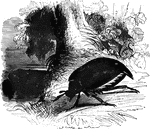
Cockchafer
"In the common European Cock-Chafer, Melolontha vulgaris, they are of considerable length,…

Spanish Fly
"These insects are common in the South of Europe, and are especially abundant in Spain, where they are…

Turnip Fly
The European Turnip-Fly, Haltica nemorum, one of the most destructive species, belongs to a…
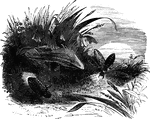
Glowworm
"The female is chiefly luminous. It is a flat, grayish-brown creature, rather more than half an inch…

Mealworm
"Tenebrio Molitor. Commonly known as the mealworm or the mealworm beetle. Common in Europe and in this…
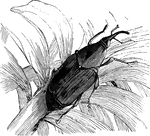
Palm Weevil
"Found in South Ameica, is a very large species, nearly two inches long; it is black, and lives on the…

